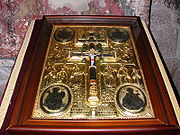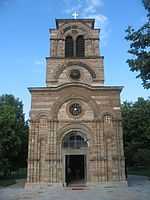Visoki Dečani
| Visoki Dečani | |
|---|---|
|
Native name Serbian Cyrillic: Високи Дечани | |
|
Visoki Dečani church | |
| Location | Dečani, Kosovo[lower-alpha 1] |
| Coordinates | 42°32′48.9984″N 20°15′57.999″E / 42.546944000°N 20.26611083°ECoordinates: 42°32′48.9984″N 20°15′57.999″E / 42.546944000°N 20.26611083°E |
| Elevation | 661 m (2,168.6 ft) |
| Founded | 1327 |
| Official name: Medieval Monuments in Kosovo | |
| Type | Cultural |
| Criteria | ii, iii, iv |
| Designated | 2004 (28th session) |
| Reference no. | 724 |
| State Party |
|
| Region | Europe and North America |
| Official name: Манастир Дечани | |
| Type | Monument of Culture of Exceptional Importance |
| Designated | 1947 |
| Reference no. | СК 1368[1] |
 Location of Visoki Dečani within Kosovo | |
Visoki Dečani (Serbian Cyrillic: Високи Дечани, Albanian: Manastiri i Deçanit) is a major Serbian Orthodox Christian monastery located in Deçan, Kosovo.
History
The Visoki Dečani monastery is located by the Dečanska Bistrica river gorge at the foot of the Prokletije Mountains, in western Kosovo.[2][3] It is located about 2 kilometres (1.2 mi) from the town of Dečani.[4] The monastery is owned by the Serbian Orthodox Church, Dečani Monastery Administration; it is managed by the Eparchy of Raška and Prizren. The monastery has been under the legal protection of Serbia since 1947.[2]
Construction
Construction began during the reign of Serbian King Stefan Uroš III Dečanski in 1327 and the original founding charter from 1330 has been preserved.[5] Stefan Uroš's son, Stefan Dušan, seized the Serbian throne in 1331 and had his father strangled to death in the Zvečan Fortress shortly afterwards. Stefan Uroš was buried in the still incomplete Visoki Dečani monastery in 1331 and its construction was continued by Stefan Dušan.[6] The monastery's main architect was Fra Vita, a Franciscan monk from the Montenegrin coastal town of Kotor.[4][6] Construction of the Visoki Dečani monastery lasted for a total of 8 years, and ended in 1335. The wooden throne of Hegoumenos was finished at around this time, and the church interior was decorated. Stefan Uroš's carved wooden sarcophagus was finished in 1340.[5]
15th–19th century
Bulgarian writer Gregory Tsamblak, author of The Life of Stefan Dečanski, was the head (hegoumenos) of the monastery at the beginning of the 15th century. The painter-monk Longin spent two decades in the monastery during the second half of the 16th century and created 15 icons with depictions of the Great Feast and hermits, as well as his most celebrated work, the icon of Stefan Uroš. In the late 17th century, the Turks plundered the monastery, but inflicted no serious damage.[5]
20th and 21st century
During World War II, the monastery fell within the territory of the Italian-ruled Albanian Kingdom and was targeted for destruction by the Albanian nationalist Balli Kombëtar and Italian fascist blackshirts in mid-1941. The Royal Italian Army responded by sending a group of soldiers to help protect the monastery from attack.[7][8]
The monastic treasure was exhibited in the rebuilt medieval refectory in 1987.[2] The monastery's monks sheltered refugees of all ethnicities during the Kosovo War, which lasted from March 1998 to June 1999.[3] On 7 May 1998, the corpses of two elderly Albanians were found 400 metres (1,300 ft) from the monastery. They were reportedly killed by the Kosovo Liberation Army (KLA) for collaborating with Serb forces. The KLA staged an attack not far from the monastery on 8 May, killed 1 person and wounding 4 others. That evening, Deçan's 300 remaining Serbs came to the monastery to seek shelter.[9] The Albanian civilians seeking refuge in the monastery returned to their homes following the withdrawal of Serb military personnel from Kosovo in June 1999. An Italian unit of the Kosovo Force (KFOR) was subsequently assigned to guard the monastery, which was attacked on several occasions.[8] Dozens of Romanis sought sanctuary in the monastery over the next several months, fearing retaliatory attacks by their Albanian neighbours, who accused them of collaborating with the Serbs and looting Albanian homes.[10]
During violent unrest in Kosovo on 17 March 2004, KFOR defended the monastery from an Albanian mob trying to throw molotov cocktails at it. Several Albanians were shot and wounded in the clash.[11] On 2 July 2004, the monastery was declared a World Heritage Site by the United Nations Educational, Scientific and Cultural Organization (UNESCO).[4] UNESCO cited it as "an irreplaceable treasure, a place where traditions of Romanesque architecture meet artistic patterns of the Byzantine world."[3] The monastery, along with all other Serbian Medieval Monuments in Kosovo, was added to the UNESCO list of endangered World Heritage sites in 2006.[5] Suspected Kosovo Albanian insurgents hurtled hand grenades at the monastery on 30 March 2007, but caused little damage. In recent years, the situation around the monastery has stabilized and it has reopened to visitors.[3] Serbian President Boris Tadić attended a service at the monastery in April 2009.[12] U.S. Vice President Joe Biden visited the monastery the following month.[13]
Architectural features
The church has five-nave naos, a three-part iconostasis, and a three-nave parvise. With a dome, it is 30 m high. Its outer walls are done in alternate layers of white and pink marble. The portals, windows, consoles, and capitals are richly decorated. Christ the Judge is shown surrounded by angels in the western part of the Church. Its twenty major cycles of fresco murals represent the largest preserved gallery of Serbian medieval art, featuring over 1000 compositions and several thousand portraits.
Gallery
-
Katholikon gate
-

Christ Carrying the Cross, a fresco from Dečani.
-

The Marriage at Cana, fresco from Dečani.
-

The House of Nemanjić, fresco from Visoki Dečani monastery
-
Relic of the True Cross
-

Crucifixion of Christ.
See also
Annotations
- ↑ Kosovo is the subject of a territorial dispute between the Republic of Serbia and the Republic of Kosovo. The latter declared independence on 17 February 2008, but Serbia continues to claim it as part of its own sovereign territory. Kosovo's independence has been recognised by 108 out of 193 United Nations member states.
References
- ↑ Serbian Academy of Sciences and Arts 2006.
- ↑ 2.0 2.1 2.2 World Heritage Committee 2003.
- ↑ 3.0 3.1 3.2 3.3 Burke March 2009.
- ↑ 4.0 4.1 4.2 Elsie 2010, p. 72.
- ↑ 5.0 5.1 5.2 5.3 UNESCO 2006.
- ↑ 6.0 6.1 Judah 2000, p. 23.
- ↑ Judah 2000, p. 131.
- ↑ 8.0 8.1 Judah 2002, p. 287.
- ↑ Judah 2002, p. 158.
- ↑ Judah 2002, p. 288.
- ↑ King & Mason 2006, p. 14.
- ↑ BBC 17 April 2009.
- ↑ Tanner 22 May 2009.
Sources
- "Serbian president visits Kosovo". BBC. 17 April 2009.
- Burke, Kathleen (March 2009). "Endangered Site: Visoki Decani Monastery, Kosovo". Smithsonian Magazine.
- Elsie, Robert (2010). Historical Dictionary of Kosovo. Lanham, Maryland: Rowman & Littlefield. ISBN 978-0-8108-7483-1.
- Judah, Tim (2000). The Serbs: History, Myth and the Destruction of Yugoslavia (2nd ed.). New Haven, Connecticut: Yale University Press. ISBN 978-0-300-08507-5.
- Judah, Tim (2002). Kosovo: War and Revenge. New Haven, Connecticut: Yale University Press. ISBN 978-0-300-09725-2.
- King, Ian; Mason, Whit (2006). Peace at Any Price: How the World Failed Kosovo. Ithaca, New York: Cornell University Press. ISBN 978-0-8014-4539-2.
- "Visoki Dečani". Serbian Academy of Sciences and Arts. 2006.
- Tanner, Adam (22 May 2009). "Biden visit to Kosovo monastery splits Serbian Orthodox Church". Reuters.
- "Medieval Monuments in Kosovo". UNESCO. 2006.
- "Dečani (Serbia–Montenegro)" (PDF). World Heritage Committee. 2003.
Further reading
- Bratislav Pantelić, The Architecture of Dečani and the Role of Archbishop Danilo II, Reichert Verlag, 2002.
External links
| Wikimedia Commons has media related to Visoki Dečani. |
| ||||||||||||||||||||
| ||||||||||||
| ||||||||||||||||||||||||||||||||||||||||||||||||||||||||||||||||||||||||||||||||||||||||||||||||||||||||||||||||||||||||||||||||||||||||||||||||||||||||||||||||||||||
_-_by_Pudelek..jpg)



